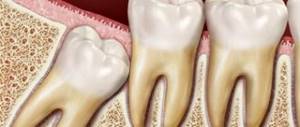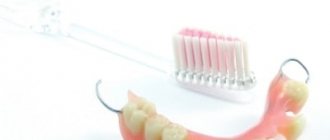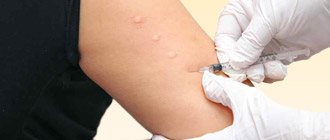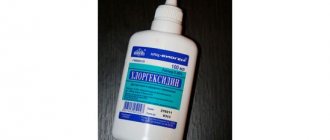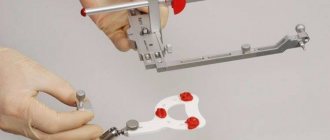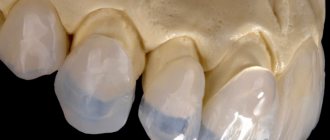1491
Not all people attach importance to the integrity of the dentition, i.e. the existence of every anatomical element on the jaw arch, which is a gross mistake.
The absence of at least one unit, especially in the frontal zone, can not only affect the aesthetics of the smile, but also the functionality of the entire dental system and the body as a whole.
Dentistry today has several methods for replacing missing incisors, allowing this procedure to be carried out as quickly, painlessly and efficiently as possible in aesthetic and functional terms.
Why might a defect occur?
The absence of teeth is called “edentia”. It comes in the following types:
- primary: teeth did not erupt at all,
- secondary: the incisors were lost some time after eruption,
- partial: missing 1 or several teeth,
- complete: all teeth are missing.
As for the absence of incisors, both primary and secondary partial adentia can be observed here. Secondary occurs as a result of progressive caries, periodontitis or trauma (blows, bruises). Primary adentia may appear for the following reasons:
- heredity: cases of genetic transmission of anomalies of the dental system from generation to generation are quite common,
- congenital developmental pathologies: diseases of a woman during pregnancy, disruptions in intrauterine development can provoke adentia in the primary occlusion,
- developmental pathologies after birth: as for permanent dentition, primary adentia here can appear due to serious health problems in early childhood or due to diseases of the milk “ones” and “twos” (the first and second incisors, respectively). It has been proven that the developing rudiments of permanent teeth can be damaged due to caries, pulpitis or periodontitis in a child, as well as due to poor nutrition or lack of calcium and vitamin D
Read on the topic: what is adentia and how to treat it.
Clinical picture
The term used in dentistry to describe the absence (loss) of teeth, including incisors, is adentia.
Based on the time of occurrence, this pathological condition is usually divided into two forms - primary or secondary.
The first form of adentia is usually congenital, and its primary signs are detected in children using radiography.
The photograph demonstrates the absence of rudiments and the presence of trema (space between already erupted elements). The phenomenon is diagnosed in 1 in 100 babies and can be asymmetric or symmetrical.
Important: the peculiarity of the primary form of adentia is the absence of any negative sensations in the child.
The lack of incisors does not cause any special problems, other than aesthetic ones. If edentia is left unattended, problems with the gastrointestinal system, pronunciation, and psychological complexes may also arise in the future.
Secondary adentia develops due to the loss of incisors after their eruption due to a number of circumstances. The long-term absence of elements of the frontal area causes increased abrasion of the enamel coating (hyperesthesia).
Difficulties with eating and facial asymmetry (when soft tissues “sink” in the area of the cheeks and lips) may also occur. The consequence of all of these conditions is a deterioration in human health and quality of life.
Symptoms and manifestations of edentia
The main sign of edentia is the absence of a tooth. Moreover, it can be impacted and located in the gum or jaw bone (it can only be seen with the help of an x-ray), or be absent altogether. There are situations when, along with primary edentia of the incisors, the absence of fangs is observed. As for the location of the defect, most often the absence of incisors is observed in the upper jaw. And in terms of the frequency of detection of pathology, the bulk of visits to the dentist come from patients with edentulous lateral incisors (“twos”). The presence of adentia is not only external manifestations, but also unpleasant symptoms that bring discomfort:
- inflammation of the gums,
- shifting of the fangs towards the central incisors: “gaps” are formed between the teeth - threes,
- increased abrasion of enamel,
- advancement of antagonist teeth: located opposite the defect site on the opposite jaw,
- speech defect: gaps in the dentition lead to incorrect positioning of the tongue, which causes hissing and whistling sounds.
Is it possible not to treat edentulous incisors - the main dangers
The incisors enter the smile zone, so their absence becomes noticeable to others. Often the patient hears uncomfortable questions, such as “what’s wrong with your teeth?” As a result, the person becomes withdrawn and tries not to speak or smile in public, because... self-esteem decreases. In addition to psycho-emotional disorders, physiological problems appear - the gums are injured when biting off rough food, pieces of food get stuck in the wide interdental spaces. Food plaque becomes a breeding ground for dangerous microorganisms. As a result, cervical caries appears on the canines and premolars, gingivitis occurs and its complication is periodontitis.
Due to improper chewing, muscle tone decreases and problems arise with the temporomandibular joint (clicking is heard when opening/closing the mouth, jaw movement becomes difficult). As you can see, there are quite a lot of problems. Therefore, you should not delay treatment - you should definitely consult a dentist.
Diagnostic methods before treatment
It is very important to conduct a complete diagnosis in order to prescribe appropriate treatment. For these purposes, in addition to interviewing the patient and visual examination, an X-ray examination is performed. This could be a classic X-ray, TRG (teleradiography), computed tomography or even multispiral tomography. The presence/absence of impacted teeth, the position and type of developing rudiments, the condition of the roots of the primary occlusion, the volume and structure of bone tissue are assessed. Diagnostics is painless and safe, because performed on modern equipment. But you should warn the doctor if the patient is pregnant or if there are metal implants in the body.
It is important to know! If the patient has chosen implantation, then in addition to X-ray diagnostics, he will need to take blood and urine tests, and if there are deviations in the indicators, contact a therapist. The fact is that implantation is considered a serious intervention in the body (compared to other methods), and accordingly, preparation for it is more serious.
Prosthetics of molars at the ILATAN clinic
Modern dentistry offers many durable solutions that provide maximum patient comfort while at the same time providing excellent aesthetic, functional and therapeutic results. When choosing a prosthetic restoration, we take into account the patient's existing conditions and expectations. By scheduling a free consultation with an orthopedist or implantologist at any of the ILATAN family dentistries by phone, you will find out which dental restoration option is right for you and can take advantage of high-quality dental services at affordable prices.
Treatment methods for children and adults
Classic treatment of missing incisors can be carried out in two ways - orthodontic and orthopedic. An orthodontist is a dentist who corrects bites using various devices and systems. And an orthopedist (also called a “prosthetist”) places crowns, bridges and various removable dentures. Moreover, prosthetics can be performed not only on adults, but also on children with primary occlusion.
Read on the topic: what types of bridges are there?
Treatment of adentia is also possible surgically - namely, with the help of dental implantation. Today, implantation is the most modern method, but it is not suitable for all patients. Let us further understand the nuances of various methods of treating edentia.
Orthodontic methods (teeth displacement)
You need to understand that orthodontic treatment methods, for the most part, are the predecessors of prosthetics and are carried out to correct the bite and close the teeth. It can be difficult to install a denture right away, without visiting an orthodontist, because... the fangs move to the places of the missing lateral incisors, making prosthetics impossible.
Goals of orthodontic treatment
- distal displacement of the canines (towards the lateral areas): towards the premolars and molars. The most common correction method to free up space for prosthetics of the upper incisors (also used on the lower jaw),
- displacement of the canines towards the central incisors: Independent clinical studies by European orthodontists1 have shown that positioning the canines in the place of “twos” is not justified in the long term. Yes, the canine (as well as premolars and molars) can be moved to the center, but over time the size of the jaw changes - as a result, the picture of a straight bite is observed. Complications include abrasion of the enamel and disruption of the jaw joint, and the patient again requires long-term treatment at the dentist.
Methods of orthodontic treatment
Records and trainers
Orthodontic plates and trainers are most often used in children with primary and mixed dentition, but they can also be worn by adults (as preparation for the installation of braces). Treatment in preschool and early school age becomes successful due to the structural features of the children's dental system, because the bones are still quite soft. With the help of trainers and plates, space is preserved in the dentition so that a prosthesis can be installed in the future.
Installation of bracket systems
Braces systems are used in adolescents after a change in bite - from about 12-14 years old, as well as in adults. A very effective technique, and now there are many options to make the treatment more aesthetic. To move the fang, various rods and springs are attached to the system. After the correction is completed, it is necessary to wear retainers - these can be trainers or other aligners that do not allow the canine to move back to the center.
Aligners – soft “braces”
In recent decades, dentistry has made great strides forward, thanks to innovative technologies and materials. You can correct your bite and adjust the position of your teeth not only with traditional braces, but also with soft aligners - analogues of braces. These transparent structures look very aesthetically pleasing, they can be removed independently, and they work no worse than classic braces. Used in patients over 12 years of age. The cost of treatment is 2-3 times higher than traditional braces.
Orthopedic methods (tooth replacement)
Prosthetics is possible in two ways - removable and fixed dentures. As for removable dentures (immediate dentures, clasp dentures, acrylic ones), they can only be considered as a temporary solution, since their fastening is very unreliable and the aesthetics are low. Therefore, fixed prosthetics in the absence of incisors is a priority in treatment. Let us further dwell on commonly used options for the restoration of defects.
Artistic extension
If the gaps on the sides of the fang are not very pronounced, or the dental crowns themselves are quite wide, then the method of artistic restoration with a filling is used. Using a special composite material that exactly replicates the natural color and translucency of the enamel, the crowns are increased in width. The extension is quite aesthetic and can be used on children (if the child is able to sit in a chair for a long time, because the work is not fast). The downside is the low service life and the material’s susceptibility to chipping.
Veneers and Lumineers
Microprostheses – veneers, lumineers – are an excellent option to close gaps and recreate the aesthetics of a smile. The principle of operation is as follows: thin ceramic linings are attached to the frontal incisors and canines. They should be slightly wider than the crowns themselves (to “hide” the defect). Veneers and lumineers are installed in patients over 18 years of age. Ceramic veneers last more than 7 years, and zirconium onlays last from 20 years. The solution is considered quite modern, but patients should remember that biting food with the front teeth is prohibited due to the risk of chipping - you will have to first cut the food into small pieces. As for installing veneers, the “native” enamel of the front teeth will have to be ground down a little. Treatment is considered quite expensive.
Bridges
Bridges (or “bridges” as patients call them) are several crowns joined together, with the outermost crowns being placed on abutments. Bridges are considered a traditional method of restoration and will actually wear comfortably for a while. But do not forget that the supporting elements are often first depulped (the nerve is removed) and must be ground down. That is, if the tightness of the connection is broken, bacteria penetrate into the abutment tooth. As a result, after a few years, the supports may collapse from secondary caries, and the patient will lose all the teeth in the “smile zone.”
Adhesive prostheses
An adhesive prosthesis is also essentially a bridge and looks like a crown with “wings” on the sides - these elements serve as attachments to adjacent teeth on the lingual side of the row. The method has a number of advantages - adhesive prostheses can be placed on children and adolescents, the structures are quickly manufactured and fixed, the supports do not need to be turned. The disadvantages include frequent violations of fixation. Adhesive dentures are very often placed after orthodontic treatment in children, when it is necessary to preserve space for the lateral incisors and wait until the age of 18 to install implants.
Dental implantation
Implantation is considered the most progressive method of restoring any number of missing elements of a row. This is the only prosthetic method that completely restores aesthetics and functionality, because The jaw bone in which the implant is located is fully utilized. As a result, the chewing load is distributed evenly throughout the entire row, and the patient forgets about discomfort and pain and can use artificial teeth as natural ones.
When choosing an implant, you should remember that large manufacturers - Nobel Biocare, Straumann, Astra Tech - produce truly durable metal “roots” with a 99% survival rate. That is, if you install such an implant at the age of 18, you can live with it for the rest of your life. But you cannot forget about the rules for caring for implants, otherwise the service life will be significantly reduced.
Good to know! If the service life of implants (metal rods installed in the bone) is really very long and is estimated in decades, then the upper part of the prosthesis - the crown on the implant - usually lasts much less. Zirconium crowns are considered the most reliable and aesthetically pleasing, with a wear life of 25 years or more.
Price
The amount of payment for restoring the integrity of the dentition in the absence of incisors depends on several factors:
- the nature of the problem;
- materials, medicines, equipment used in the process;
- actual amount of work;
- clinic status;
- doctor's qualifications.
The estimated cost for the methods of eliminating edentia discussed above are presented in the table:
| Methodology | Average price in rubles |
| Adhesive prostheses | |
| plastic | 1 000 |
| cobalt-chrome | 3000-4000 |
| metal-ceramic | 5 000-6 000 |
| Braces systems (for 1 jaw) | |
| made of metal | about 30,000 |
| sapphire | from 55 000 |
| ceramic | from 40 000 |
| Filling material | 5 000 |
| Vining | 20 000-25 000 |
| Implantation | from 30 000 |
Important: more accurate information on the cost of treatment must be clarified at the selected clinic. Discounts, promotions, and a bonus system can significantly reduce the total cost of the procedure.
Duration of treatment
When considering the timing of defect elimination, we must not forget about what goal the patient is achieving. If you need restoration “right now,” then in 2-3 hours you can add a filling or make a temporary plastic crown. Veneers, bridges and adhesive prostheses are made to order. Here the timing greatly depends on the workload of the dental office - i.e. You can wait for a prosthesis for 3 days, or even 30. And if the patient wants original lumineers, which are made only at the manufacturer, then the waiting period is not yet several weeks.
Orthodontic treatment takes from 6 months or more, depending on the complexity of the individual case. The operation to install implants lasts about 1 hour. If implantation is carried out using immediate or accelerated loading protocols, the crown is placed on the implant within 30 days. If classical implantation with delayed loading was carried out, then a permanent crown is placed after 2-4 months (while the patient walks with a temporary one).
Implantation methods for complete absence of teeth
Classical two-stage implantation for edentulous patients is rarely used, since in almost 100% of such diagnoses bone tissue atrophy is observed; this method will require large-scale plastic surgery. Therefore, other protocols are preferred.
All on 4, 6 or 8 implants
Implantation in the clinic is carried out without pain using modern anesthetics. The doctor simply inserts a pin through the soft tissues and punctures them. New methods all on 6 (4) or all on 8 allow the installation of prostheses on 4, 6, 8 implants in case of bone tissue deficiency, without resorting to bone grafting. The protocol is available for patients with moderate bone thinning.
Accordingly, if there is a severe deficiency of bone tissue, specialists perform bone grafting - grafting natural or artificial bone.
The essence of the “all on 4” method: 2 implants are implanted in the frontal zone, and the other 2 in the lateral sections at an angle of up to 45o, this increases the contact area between the pin and the bone and increases the reliability of fixation.
This is an operation with immediate loading of a temporary structure, which is replaced after complete healing (maximum after six months) with a permanent one. The intervention is performed by experienced surgeons who accompany the patient from the moment of the first visit to the clinic until complete recovery.
Basal implantation technique
We draw the attention of patients that the German Implant Center DOES NOT CONSIDER
basal implantation as permanent. Basal implantation of the jaw in the complete absence of dental units is justified and can be useful only as a temporary structure, which is then replaced with classic implants in 100% of cases. “Basalka” is applicable for severe bone deficiency. No bone augmentation is required during the procedure.
Basal implant models are installed not in the superficial bone tissue, but in the deep basal layers, which do not atrophy. The central part is implanted with standard classical implants. It is possible to implant up to 2 basal implants into the extreme lateral segments. Prosthetics are performed after surgery, the prostheses are similar to those installed according to the all on 6 protocols (4).


